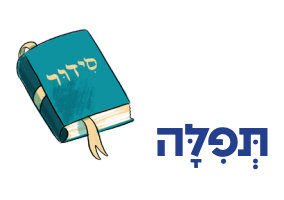Illustration credit: Rivka Tsinman

Prayer in the Parashah תְּפִלָּה
When Amalek attacks, Moshe prays – with his hands. Benei Yisrael are stronger when he raises his hands, but Amalek is stronger when he lowers his hands (Shemot 17:11 and see Understanding the Verses).
A midrash explains how this worked:
וְכִי יָדָיו שֶׁל מֹשֶׁה עוֹשׂוֹת מִלְחָמָה אוֹ שׁוֹבְרוֹת מִלְחָמָה?
אֶלָּא לוֹמַר לָךְ כָּל זְמַן שֶׁהָיוּ יִשְׂרָאֵל מִסְתַּכְּלִים כְּלַפֵּי מַעְלָה וּמְשַׁעְבְּדִין אֶת לִבָּם לַאֲבִיהֶם שֶׁבַּשָּׁמַיִם הָיוּ מִתְגַּבְּרִים, וְאִם לָאו הָיוּ נוֹפְלִין.
Could Moshe’s hands really determine whether they would win or lose the war?!
Actually, what happened is that when Benei Yisrael would look upwards, and turn their hearts in service to their Father in Heaven, they would win. But if they didn’t, they would lose.
Moshe’s hands were a powerful cue for prayer. Can you think of ways that your hands could help you pray?
Here are some suggestions:

- Place your hands over your heart (Rambam, Laws of Prayer 5:4)
- Put your hands behind your back (Beit Yosef OH 95)
- Fold your hands together (Rashi on Bavli Shabbat 10a)
According to the Arukh Ha-Shulhan, there’s no best thing to do with your hands when you pray. Find what works for you! (Orah Hayyim 91:7)
- Try it out! Are there parts of tefillah that you know by heart, and you could say without holding a siddur? What positions might you try out for your hands for those prayers? Or maybe try using your fingers to follow along with the words!
- Do your feelings about prayer change depending on how your hands are positioned? What is the connection between your body position and your feeling of focus in prayer?
-------------------
-------------------





